azobenzene by reduction of nitrobenzene with Mg in methanol
Azobenzene is quite interesting compound, especially its cis-trans isomerization.
I followed this procedure (there are some errors which I found later)
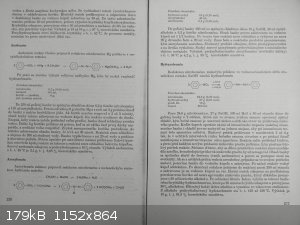
this is the correct procedure without errors:
Attachment: vogel1958.pdf (927kB)
This file has been downloaded 277 times
and this is some experimental work:
Attachment: v53-140.pdf (486kB)
This file has been downloaded 183 times
I started from this amount of reactants:
nitrobenzene 0,2 mol, Mr=123 g/mol, 24,6 g
Mg 24 g (1 mol)
I put 24,6 g nitrobenzene into 1000 ml flat bottom flask, magnetic stirbar, 440 ml of methanol, approximately 1/4 of the Mg turnings (Grignard, but
quite old, not too much shiny anymore, I grounded the pieces a little before each addition), 1 small crystal of iodine (I approximate at scale of few
mg) and attached a Liebig condenser.
There was soon very weak bubbling. I started magnetic stirring. Do not add more Mg as then stirring could be impossible. I was expecting vigorous
reaction and was prepared to cool the flask. But the temperature did not rise at all (just touching by hand) and there was no reflux from the
condenser. Only after 2 hours I realized it is necessary to heat the flask at which the reflux started so I was able to stop the heating and the heat
of the reaction was sufficient to keep reflux. I think this delayed start and necessity of heating was caused by more of water in methanol (0,1%) than
good (0,01% would be better - read the attached paper with experimental work) - well the reaction runs also with methanol with 0,1% water, just the
start is not so fast and it lasts some time until the water is decomposed by Mg + necessity of initial heating. I did not know this as it was not
mentioned in the original book (found it only later). If your reaction does not start in 10 minutes just start to heat the flask, if too vigorous cool
the flask.
When the reaction was going, there was 1 drop from condenser every 2 seconds (note the reaction is at fourfold scale of the original method).
My Mg turnings were gray, not shiny metal, probably better quality Mg would start the reaction earlier (10 minutes mentioned in the book). Using Mg
powder the reaction could be too fast and cold bath probably necessary (as mentioned in the book), but at me I had to heat the reaction to start it.
I also stirred the reaction at maximal RPM of my stirrer. I added 1/4 of Mg turnings in 1 h intervals through the top of condenser. After adding all
Mg, the reflux lasted for the next 3 hours. Then no drops from condenser, I let the reaction to stir overnight. In the morning the reaction was
complete, no scent of nitrobenzene and the content in the flask red with some white precipitate Mg(OH)2. I heated the flask and refluxed the mixture
for 30 minutes (I'm not sure whether it was necessary, the important thing is that no scent of nitrobenzene, maybe refluxing is necessary when you do
not leave it to stir overnight).
I tried to vacuum filter the mixture but the Mg(OH)2 clogged the filter soon and the vacuum made the methanol to boil so this was not good idea to do,
but I had to try it (this step is not mentioned in the book).
So I poured the reaction mixture into 800 ml of cold water. Mg(OH)2 decomposed using glacial acetic acid added dropwise while stirring till acidic pH
on litmus (slightly more than 2 mols).
Dark red crude product gravity filtered and let to air dry.
Dissolved in 100 ml of 95% boiling ethanol (dissolved quite easily, maybe less of solvent would be enough?) and filtered while hot (few mg of Mg
pieces still caught on the filter paper) and added 5 ml of water to make 90% ethanol, heated to boil and allowed to cool slowly to room temperature,
nothing crystallized so I added very tiny grain of the crude product at which crystallization started immediately and then put into fridge to 4 C
overnight. Sucked on sinter and washed with 10 ml of 4 C (cold from fridge) 95% ethanol.
Yield 8,0 g quite poor (mother liquor quite dark red, I'll try to evaporate to half of its volume and cool in fridge whether it yields something)
m.p. 66-67,5 C (lit 67,88 C trans isomer)
https://en.wikipedia.org/wiki/Azobenzene
https://pubchem.ncbi.nlm.nih.gov/compound/Azobenzene#section...
Solubility in alc = 4.2/100 at 20 °C ether; Ligroin = 12/100 at 20 °C
Lewis, R.J. Sax's Dangerous Properties of Industrial Materials. 10th ed. Volumes 1-3 New York, NY: John Wiley & Sons Inc., 1999., p. V2: 333
Sol in glacial acetic acid, alcohol, ether
O'Neil, M.J. (ed.). The Merck Index - An Encyclopedia of Chemicals, Drugs, and Biologicals. Whitehouse Station, NJ: Merck and Co., Inc., 2006., p. 155
In water solubility, 6.4 mg/L at 25 °C
pictures:
nitrobenzene in FBF:
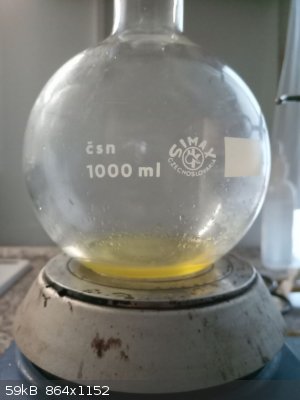
all reactants added, around the crystal of iodine (red spot) hydrogen evolution (small bubbles)
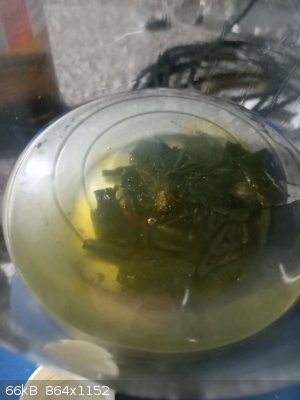
the reaction started only after heating it, then the heating was turned off and the heat of the reaction was sufficient to keep reflux, it was
necessary to vigorously stir the Mg at max RPM, sometimes it dropped to the bottom at which stirring stopped and it was hard to restart stirring then
(requires swirling in hand above the magnetic stirrer), also do not add too much Mg (the problems with stirring usually after addition of Mg)
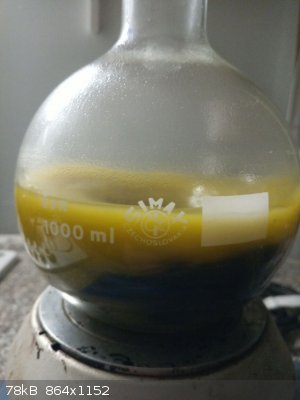
details of my old Mg turnings which I used, I ground them a little before the addition into reaction:
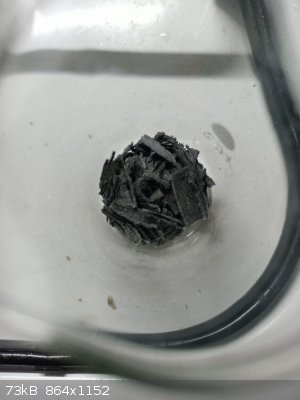
the reaction is nicely proceeding:
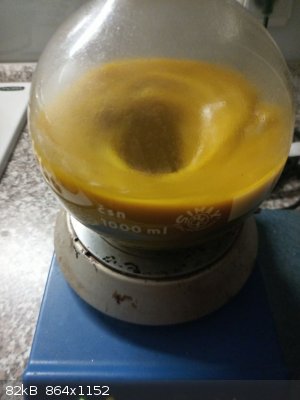 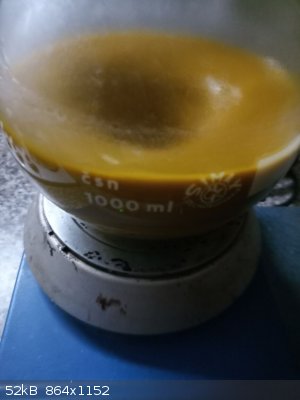 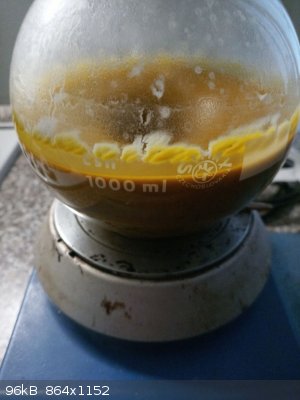 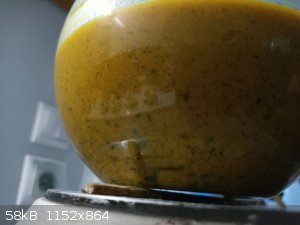 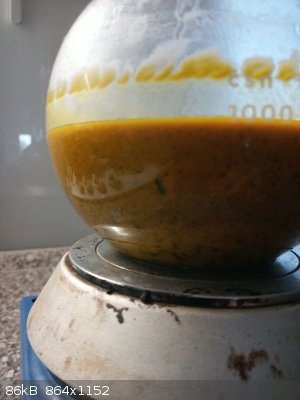 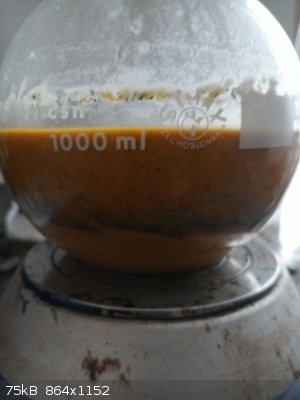
after letting it to settle for few minutes the red color of the azobenzene visible:
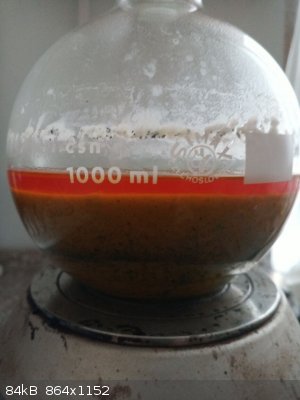
pouring the reaction into 800 ml of cold water and putting into fridge:
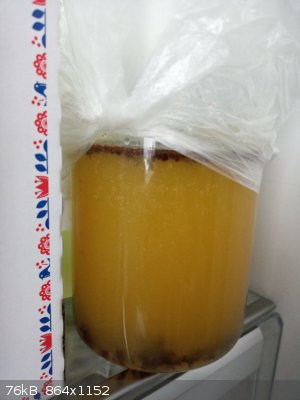
after removing from the fridge:
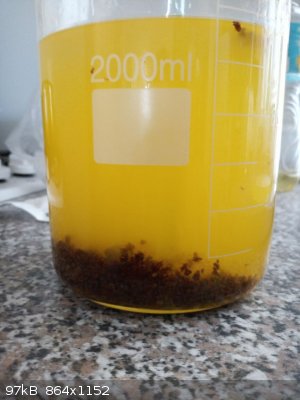
gravity filtering:
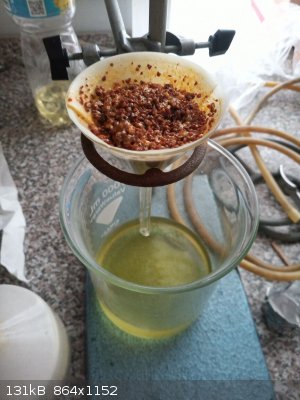
recrystallization from ethanol:
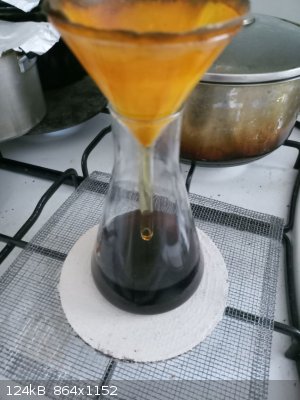 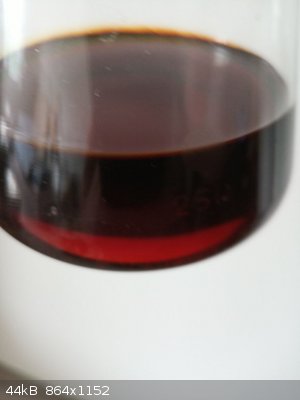 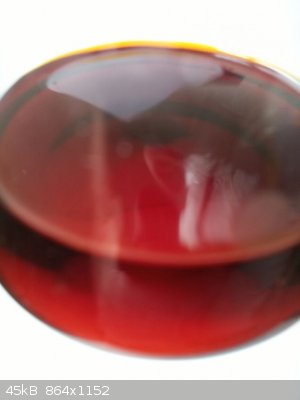
crystallization at room temperature started only after adding seed crystals and then put into a fridge to 4 C overnight:
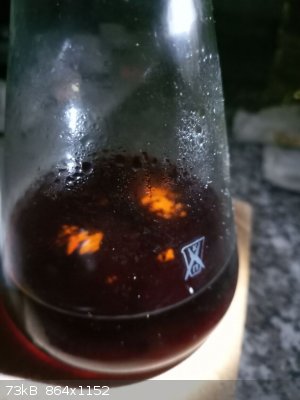
the product, still wet, the same color after air drying:
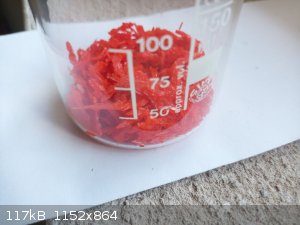 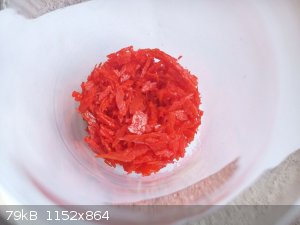 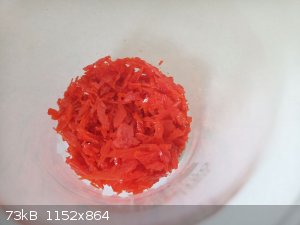
|